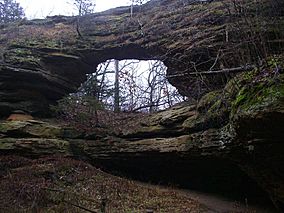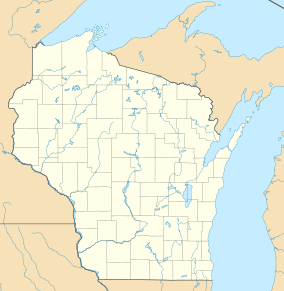Natural Bridge State Park (Wisconsin) facts for kids
Quick facts for kids Natural Bridge State Park |
|
|---|---|
|
IUCN Category V (Protected Landscape/Seascape)
|
|

Wisconsin's largest natural arch and a prehistoric rock shelter
|
|
| Location | Sauk, Wisconsin, United States |
| Area | 530 acres (210 ha) |
| Established | 1972 |
| Governing body | Wisconsin Department of Natural Resources |
|
Raddatz Rockshelter
|
|
| Lua error in Module:Location_map at line 420: attempt to index field 'wikibase' (a nil value). | |
| Location | Address restricted |
| NRHP reference No. | 78000139 |
| Added to NRHP | December 18, 1978 |
Natural Bridge State Park is a cool place in Wisconsin, USA. It's a state park that covers about 530 acres. The most amazing thing here is Wisconsin's biggest natural arch. Right under this arch, you'll find the Raddatz Rockshelter. This was a special rock shelter (a cave-like spot) used by ancient people called Paleo-Indians. Today, it's a famous historical site. The park is located southwest of Baraboo, near the towns of Leland and Denzer.
Contents
Exploring the Park's Natural Wonders
Natural Bridge State Park is located in a special area. This area is called the Driftless Area. It was not covered by glaciers during the last Ice Age. Because of this, it has unique hills and valleys.
Ancient Rocks and Formations
The park sits on the edge of the Baraboo Range. Here, you can see large rock formations called outcrops. These rocks are made of quartzite. Quartzite is a very hard rock that formed from sand. This sand was laid down about 1.6 billion years ago!
The famous natural arch and the rock shelter were formed from these quartzite outcrops. Over millions of years, wind and water slowly wore away the rock. This created the amazing shapes you see today.
The Natural Arch and Rockshelter
The top of the natural arch is about 35 feet (11 meters) above the ground. The opening of the arch is 25 feet (7.6 meters) wide and 15 feet (4.6 meters) high. It's big enough to walk through!
The Raddatz Rockshelter is right under the arch. It's a large, sheltered area that is 60 feet (18 meters) wide and 30 feet (9.1 meters) deep. Imagine how many people could have found shelter here!
Plants and Wildlife in the Park
The hills in the park are covered with forests. You'll find many oak trees and other hardwood trees. Some hilltops have small areas of prairie. These are grasslands with different types of grasses and even some cactus plants.
Around the rock walls, you can spot interesting ferns. These include the walking fern and the slender lip fern. There's also a rare plant called the purple cliffbrake. In the shady spots near the rocks, you might see a rare type of goldenrod plant.
Discovering the Park's Human History
The Raddatz Rockshelter has a very long and exciting history. People have used this shelter for thousands of years!
Uncovering Ancient Life at the Rockshelter
In 1957, a team of archaeologists studied the rock shelter. Archaeologists are like detectives who study the past. They found many clues about how people lived there. They identified bones from 50 different types of animals. They also found shells from 15 different types of snails and clams.
The oldest things they found were pieces of burned wood. These were likely from ancient campfires. These wood pieces were dated to be between 9,000 and 8,000 BCE. This means people were using the shelter over 10,000 years ago! It's the oldest known place where humans lived in the upper Midwest of the United States.
The team also found tools made from deer antlers. These tools were used for scraping things. They are about six to seven thousand years old. At first, people likely used the shelter only sometimes. Maybe they stopped there while hunting or during certain seasons. Later, it seems people lived there all year round.
How the Park Became a Protected Area
People have been visiting the natural bridge for fun since 1870. It became a state park in 1972. The next year, a special 60-acre area around the arch was given extra protection. It was named the Natural Bridge and Rockshelter State Natural Area. In 1978, the Raddatz Rockshelter was officially added to the National Register of Historic Places. This means it's a very important historical site!
Fun Things to Do at Natural Bridge State Park
Natural Bridge State Park is open all year. There aren't always staff members there. If you drive, you'll need to buy a parking pass. You can get one from a self-registration stand.
Park Facilities and Rules
The park has basic facilities for visitors. You'll find picnic tables where you can enjoy a meal. There are also restrooms available. Please note that you cannot camp overnight at this park.
Hiking and Exploring Trails
There are two main trails in the park. Together, they are about 3.5 miles (5.6 kilometers) long.
- The Indian Moccasin Nature Trail is a shorter loop. The natural arch and rock shelter are just a short walk up this trail. As you walk, you'll see signs that tell you about the different plants. These signs explain how Native Americans used many of these plants for medicine.
- The Whitetail Hiking Trail is longer. It crosses the highway and goes into the southern part of the park. This area is usually less busy.
Hunting Opportunities
During certain times in the autumn, the southern part of the park is open for hunting.



